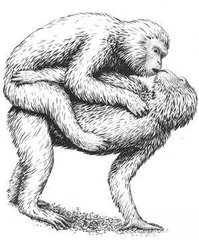Mounting, Diddling, and Bump-Rumping: Sexual Techniques
Affectionate activity often leads to, or is inseparable from, overtly sexual behavior—defined here as any contact between two or more animals involving genital stimulation. Stumptail and Crab-eating Macaques, for example, kiss their same-sex partners during sexual mounting. In fact, mounting is the most common type of sexual behavior found in homosexual contexts: one animal climbs on top of the other in a position similar to heterosexual intercourse, usually from behind in a front-to-back position (that is, one animal mounted on the back of the other). More than 95 percent of mammal and bird species use this position, for both male and female homosexual interactions. On the other hand, some animals—particularly primates such as Gorillas, Bonobos, and White-handed Gibbons—use a face-to-face position (in addition to, or instead of), and in some cases this is more common in homosexual encounters than in heterosexual ones. Belly-to-belly copulation is also the norm for both homosexual and heterosexual interactions in Dolphins. Occasionally more unusual or “creative” mounting positions are used, particularly by female animals. In Bonobos, Stumptail Macaques, and Japanese Macaques, for instance, females sometimes interact in a supine or semirecumbent position, one individual behind the other with her partner between her legs or sitting “in her lap” (which may also be done in a face-to-face position). Occasionally female Warthogs, Rhesus and Japanese Macaques, Koalas, and Takhi mount their female partner from the side rather than from behind; lateral mounts also sometimes occur during heterosexual interactions in these (and other) species. And in some animals a “backward,” head-to-tail mounting position is occasionally used, e.g., in Botos, Hammerheads, Ruffs, and Western Gulls. Most same-sex interactions involve only two individuals at a time, but group sexual (and courtship) activity—involving anywhere from three or four (Giraffes, Lions) to six or more (Bowhead Whales, Mountain Sheep) partners—occurs in over 25 different species.
The actual type of genital contact varies widely. Full penetration in male anal intercourse occurs in some species (for example, Orang-utans, Rhesus Macaques, Bison, and Bighorn rams), while female penetration of various types occurs during lesbian interactions in Orang-utans (insertion of the finger into the vagina), Bonobos (insertion of the erect clitoris into the vulva), and Bottlenose and Spinner Dolphins (insertion of a fin or tail fluke into the female’s genital slit). Simple pelvic thrusting and rubbing of the genitals on the rump of the other animal is widespread in both male and female homosexual mounts (occurring in the Northern Fur Seal, Lion, and Proboscis Monkey, among others), and simple genital-to-genital touching is the form of homosexual (and heterosexual) contact in species where males do not have a penis (as in most birds, such as the Pukeko and Tree Swallow). A more unusual type of male homosexual contact involves various forms of non -anal penetration. In Whales and Dolphins, both males and females have a genital slit or opening; when not aroused, the male’s penis is contained in the cavity leading to this slit. Homosexual activity in Bowhead Whales, Bottlenose Dolphins, and Botos sometimes involves insertion of the penis of one male into the genital slit of the other. Other more unusual forms of penetration have also been documented: male Botos occasionally insert the penis into a male partner’s blowhole (on the top of his head!), while male Orang-utans have even been observed retracting their penis to form a sort of “hollow” or concavity that another male can penetrate. Clitoral rubbing or other types of genital tribadism are found in female Bonobos, Gorillas, and Rhesus Macaques (among others), while males in several species (e.g., White-handed Gibbons, West Indian Manatees, and Gray Whales) rub their penises together or on each other’s body. In male Bonobos, mutual genital rubbing sometimes takes the form of an activity with the colorful name of “penis fencing,” in which the males hang suspended by their arms and rub their erect organs against each other.
Oral sex of various kinds also occurs in a number of species. This may involve actual sucking of genitals (fellatio between males in Bonobos, Orang-utans, Siamangs, and Stumptail Macaques); licking of genitals (cunnilingus in Common Chimpanzees, Long-eared Hedgehogs, and Kob antelopes; penis-licking in Thinhorn Sheep and Vampire Bats; genital licking in female Spotted Hyenas and male Cheetahs); mouthing, nuzzling, or “kissing” of genitals (female Gorillas, male Savanna Baboons, Crab-eating Macaques, and West Indian Manatees); and genital sniffing in female Pronghorns and Marmots as well as scrotal sniffing in Whiptail and Red-necked Wallabies. Male Stumptail Macaques even perform mutual fellatio in a sixty-nine position, while males of a number of primate species (including Gibbons, Bonnet and Crested Black Macaques, and Nilgiri Langurs) sometimes actually eat or swallow their partner’s (or their own) semen—though usually after mutual genital rubbing or manual stimulation rather than oral sex. 9Dwarf Cavies and Rufous Bettongs occasionally indulge in anal licking, nuzzling, and sniffing with same-sex (and opposite-sex) partners. Another sort of “oral” sexual activity is called beak-genital propulsion and occurs among both male and female Bottlenose and Spinner Dolphins: one animal inserts its snout or “beak” into the genital slit of another, simultaneously stimulating and propelling its partner forward while swimming (a similar behavior in Orcas, involving simple nuzzling or touching of the genitals with the snout, is known as beak-genital orientation).
A male Giraffe mounting another male

Another type of activity found during homosexual interactions is masturbation, in which one animal stimulates its own or its partner’s genitals with a finger, hand, foot, flipper, or some other appendage. For example, male Savanna Baboons often touch, grab, or fondle the genitals of another male—this behavior is known aptly as diddling—while male Bottlenose Dolphins and West Indian Manatees sometimes rub another male’s penis with their flippers. Male Rhesus and Crested Black Macaques, female Gorillas, male Vampire Bats, female Proboscis Monkeys, and male Walruses sometimes masturbate themselves when mounting, courting, or interacting sexually with another animal of the same sex. Mutual masturbation in a side-by-side sixty-nine position occurs in female Crested Black Macaques, while male Bonnet and Stumptail Macaques masturbate each other and even fondle one another’s scrotums. Another form of mutual masturbation in these species involves two males backing up toward each other and fondling each other’s genitals between their legs. In Bonobos and Common Chimpanzees, individuals often rub their anal and genital regions together while in this rump-to-rump position, prompting zoologists to give these behaviors names like “rump-rubbing” and “bump-rump.” Other more unusual forms of “manual” stimulation include mutual genital stimulation using trunks in female Elephants, and anal stimulation and penetration with fingers by male Common Chimpanzees, Siamangs, and Crab-eating Macaques.
Consorts, Satellites, and Triumvirates: Same-Sex Mates and Pair-Bonding
Wild animals often form significant pair-bonds with animals of the same sex. Homosexual pair-bonding takes many different forms, but two broad categories can be recognized: “partners,” who engage in sexual or courtship activities with each other, and “companions,” who are bonded to each other but do not necessarily engage in overt sexual activity with one another. More than a third of the mammals and birds in which homosexual activity occurs have at least one of these types of same-sex bonding. The archetypal example of a “partnership” is the mated pair: two individuals who are strongly bonded to one another in a way that is equivalent to heterosexually paired animals of the same species. Partners engage directly in courtship, sexual, and/or parenting behaviors; they usually spend a significant amount of time with each other; and they do similar activities together. This is found primarily in birds (more than 70 different species)—not surprisingly, since heterosexual pairing is typical of feathered creatures (but generally rare in other animal groups). Examples of homosexual mates are found in male Black Swans and Black-headed Gulls, and female Black-winged Stilts and Silver Gulls (among many others). In mammals, partnerships take many different forms, including “consortships” in female Rhesus and Japanese Macaques, “sexual friendships” in Stumptail and Crab-eating Macaques, “tending bonds” between male Bison, and “coalitions” between male Bonnet Macaques, Savanna Baboons, and Cheetahs. Some animals, while not necessarily forming same-sex bonds, do have “preferred” or “favorite” sexual and affectionate partners with whom they tend to interact more often than with others: this is true for Bonobos, Gorillas, Killer Whales, and Dwarf Cavies, among others.
Читать дальше













